
How to choose a solar charger that even cultural hikers can easily understand
table of contents
- New "mountain tools" essential for the outdoors of the future
- Where should I focus?
- Step 0: Before you buy - Do you really need a solar charger? ~
- Step 1: Choose the output - Is it wrong to charge because it's high output?
- Step 2: Choose a storage method - Don't waste your power generation
- Step 3: Choose based on usability - Check out the ease of use outdoors
- summary
New "mountain tools" essential for the outdoors of the future
Smartphones, digital cameras, GPS, outdoor watches, tablets... electronic gadgets have become regulars on the equipment list in recent years.
Not only are these more safety and convenience, they are essential mountain tools for new ways to enjoy outdoor activities, such as recording and sharing photos and text. On the other hand, there is no doubt that the use of digital devices will become the norm in terms of mountain safety, as considerations have begun to be considered for the installation of Wi-Fi equipment in the Northern Alps
However, as I started carrying so many electronic devices around, I was also struggling with the problem of charging devices that have run out of battery. If you're traveling on a day or for a one-night hike, you can fully withstand a typical lithium-ion battery sold at electronics retailers at home. However, it's a different story when it comes to a few nights traverse. You will always need to charge it somewhere, and the disadvantage is that performance will be significantly reduced during snowy seasons when the temperature is low.
Where should I focus?
So what I've focused on this time is charging with a solar charger, which is currently the easiest method of generating electricity in the outdoors. Although information about this new field is widely seen in digital gadget-based media, there are currently few guides and verification articles that can be used as a reference from the perspective of the outdoors. Additionally, I came to realize this while researching, and there are many topics that are difficult to understand for cultural people like me.
So, this time, we have unraveled these complex and complicated mechanisms so that even us cultural hikers can understand, and while taking the plunge and slashing away the extremely maniacal parts, we have organized the points to keep in mind in order to choose the best solar charger, so please use this as a reference when you are thinking about trying out a solar charger. , I am not a cultural person, nor am I familiar with the real science and engineering field of solar power generation. I will accept comments from professionals. If there is any error, please let us know and we will correct it.
To be safe, we cannot be held responsible for any content accuracy, safety, or malfunctions of your device, so please make your ultimate judgment at your own risk.
Step 0: Before you buy - Do you really need a solar charger? ~
Before we move on to discuss solar chargers, we can organize various charging methods outdoors without an outlet to begin with, so that you can find out the best charging method for your purpose and situation, as well as the general framework for choosing the most suitable solar charger.
Summary of common outdoor charging methods
As shown in the list above, for people who usually only do day hikes, there is little
Additionally, although mobile batteries with solar panels are solid as mobile batteries, solar panels often have poor charging efficiency , so at present it is considered to be just a bonus. It is ideal for disaster prevention purposes, but it is difficult to rely on the solar section for outdoor use.
The most useful scenes where solar chargers require charging many electronic devices, and a long trip of more than two nights is far from enough power with a mobile battery . This is even better if you settle in a base camp or other area and can leave it in a place that is exposed to good sunlight forever, or if there are long areas such as ridges that are exposed to sunlight.
As I will explain later, solar chargers basically do not have the function of storing electricity generated (energy storage), so in reality, they can be used in conjunction with a mobile battery or by choosing a solar charger that is integrated with the battery, allowing you to generate electricity and store electricity without waste, making it the best combination (photo below).

Various electricity storage methods. From left to right, a nickel-hydrogen battery and built-in lithium-ion battery are used in conjunction with a mobile battery.
Step 1: Choose the output - Is it wrong to charge because it's high output?
Even if only the charger is high output, charging speed does not increase
The first thing that everyone is concerned about when choosing a solar charger is how powerfully and efficiently you can charge it quickly.
The power of a charger is generally expressed as the amount of output that can be supplied from the charger to an electronic device, and refers to the unit of power called "watts (W)." As expressed by the formula below, power is a value obtained by multiplying current and voltage, and the higher the voltage and current, the higher the output. This is a basic premise for knowing the specs of solar chargers, so it can be a hassle, but please remember.
Power (W) = Voltage (V) × Current (A)
Solar charger products are often filled with slogans such as "high power of 15W" and "speed charging up to 3A", but it is safe to assume that these formulas are spoken in mind.
If we think about it normally here, it is easy to think that "the higher the power (higher output), the faster the charger will be charged" (like me a while ago). It's not a mistake, but in reality, it's not that simple when it comes to electronic devices around you.
This is because no matter how much the maximum output of the charger (= the maximum power that can be supplied to the device) is, it cannot supply more power than the receiver's device has specified . Furthermore, the cables connecting them must also have the performance to pass currents of that strength. So another basic premise is the following principle:
3 conditions for charging at high output
1. High-output charger
2. High-output compatible devices
3. High-output compatible cable
Choose the output that suits the device you want to charge
So, how much output does the electronic device that receives it regulate? For reference, we have compiled the charging output of general electronic devices based on the numbers shown on the original adapter.
| Model | Voltage (V)/Current (A) | Output (W) |
|---|---|---|
| iPhone 5S, SE | 5.0V/1A | 5W |
| iPhone 6, 6 Plus | 5.0V/maximum 2.0A (unofficial) | 10W |
| iPad mini 4 | 5.2V/2.4A | 12W |
| Android Smartphone | 5.0V/1A 5.0V/1.8A 5.0V/1.8ADC, 9.0V/1.8A, 12.0V/1.35A (in rapid charging mode) | 5W 9W 9W, 16W |
| Nexus 7 (2013) | 5V/1.8A | 9W |
Generally, small electronic devices such as smartphones only require around 5W of output, and devices that require large power, such as tablets, are compatible with outputs that are even greater. Incidentally, there are some devices, such as smartwatches, that only support even smaller power.
What can be seen from the table above is that no matter how large a solar charger is prepared, if the device that charges the device does not support the high output, it will be wasted (although the device will automatically adjust the maximum output to charge it). If you only need to charge your smartphone, you don't need to output more than 5W.
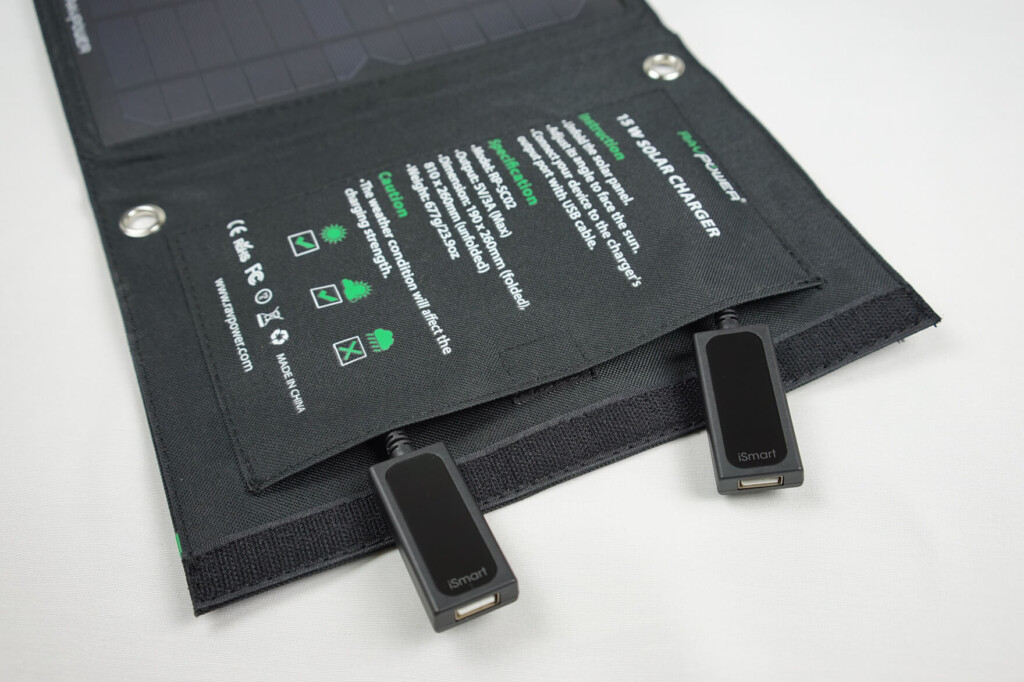
The most recent high-output models are those with multiple ports installed.
One thing to note here is that up until now, the things we've talked about when a solar charger had one charging port (USB plug-in). as shown in the photo above , the maximum output of that charger represents the total output of each port , which is very effective in that case, in that case, multiple charging at the optimum output can be used at the same time. What's important is what the maximum output value means. Make sure you check this point carefully so that you don't get fooled.
*When charging, when connecting devices that require output different from the charger's output, they should generally have safety mechanisms such as detecting an abnormality and shutting down the device, but in the worst case scenario, there is no possibility of damage, explosion, or ignition. Of course, when using the product, follow the instructions and instructions for each product, and make sure that the charger or electronic device is not abnormally heated, and be careful not to leave it connected or out of sight.
Tips for choosing
- The larger the output of the solar charger, the faster the charge, but the receiver battery and connection cable must also support the output .
- If you only have one traditional smartphone, an output of 5.0/1A (= 5W) is sufficient (more effective if you have a smartphone that supports fast charging).
- output is required to charge devices such as tablets that require large power
- A high-output charger with multiple ports allows you to quickly charge many devices at the same time.
- Ultimately, you can choose the maximum output and number of output ports that suit the required output of the device you want to charge and the number of devices .
Step 2: Choose a storage method - Don't waste your power generation
The weakness of solar chargers
It's surprisingly difficult to charge your phone in real time in the outdoors, let alone during the mountain climbing.
From a Japanese perspective, first of all, courses exposed to sunlight throughout the day cannot be considered to be that normal unless it is an Alps ridge that exceeds the forest limits. Also, even in the middle of summer, the weather is easy to change, including evening showers, and it is not often the case that sunlight is still exposed for a long time. For devices such as tablets that require high current, there is a possibility that charging does not progress at all if the sunlight is weak.
Also, even if charging proceeds successfully, if there are multiple devices, it is almost impossible and inefficient to replace it with the next device just when the charging is complete.
Overcoming the weaknesses of solar chargers when used in conjunction with a battery
To cover these two weaknesses: instability and inefficiency, solar chargers are very effective to use in conjunction with a storage battery. There are two ways to do that.
1. Bring both solar charger and mobile battery
The simplest method is what I am currently practicing. Generates electricity using a solar charger, save it in a mobile battery connected with a USB cable during the day, and then connect the necessary devices for the mobile battery to charge it later. is that you can choose the specs that satisfy you both, whether it's solar charger or mobile battery, so there is a high chance that you will most certainly be able to get equipment that is free of waste. Of course, one of the key points is to choose the battery capacity that suits the device you are charging. The drawback of this method is that the panels and batteries tend to grow in most cases, making the luggage bulky and heavy.
By the way, there are models for this type that sell a set of panels and batteries (top and left), so if you choose them, you can rest assured that they can be matched.
2. Choose a solar charger with integrated battery

On the other hand, the ideal solar charger is an integrated solar panel and battery. There are two advantages over getting a rose. One of the is that it is integrated, making it lightweight and compact . Another reason is that there is no need for cables between the solar panel and the battery, so there is less risk of electricity loss or breakage . In other words, I think it's all good because it's more compact, efficient, and more durable.
However, as I actually mentioned in the table above, I have never seen a model of this type that satisfies both solar panel and battery performance, and in most cases the battery capacity is low, or because there is only one output port, it cannot be charged a lot at the same time. Currently, there are few devices to charge, and it is a particularly lightweight and compact option that only works with people who want to carry it around.
Tips for choosing
- To generate more efficient power and charge it over long trips, we recommend using it in conjunction with a solar charger and a mobile battery . However, the weight increases accordingly, so make a decision taking into consideration the number of equipment and the number of days.
- If you are looking for compactness, we recommend a solar charger with a battery . However, the charging capacity is small, so it may not be enough if you place importance on volume, such as for long periods of time or multiple devices.
Step 3: Choose based on usability - Check out the ease of use outdoors
Output port terminal type and number
Almost all of the output ports of modern solar chargers are USB output. Basically, that's fine, but outdoors, there are devices such as GPS and portable radios that use AAA batteries, and if you're going to do so, it may be more efficient to choose a model that can charge all USB output + AAA/AA batteries .
However, even if you can get as much waste as possible, digital cameras are often rechargeable batteries that are exclusively AC powered, so personally I am unable to omit all the spare batteries for now (although if the camera has a USB port for charging directly, you can charge it from there).
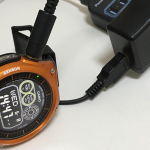 I'll go a bit off topic, but you need to be careful, despite the devices that can charge USB, the terminals are sometimes different from other devices, and have special shapes. For example, as shown in the photo, most smartwatches have one USB port, but the other has a special port shape, so the general USB (A) – USB (Micro-B) type cannot be charged. When entering the mountains, don't forget to use the charging cable that suits your device .
I'll go a bit off topic, but you need to be careful, despite the devices that can charge USB, the terminals are sometimes different from other devices, and have special shapes. For example, as shown in the photo, most smartwatches have one USB port, but the other has a special port shape, so the general USB (A) – USB (Micro-B) type cannot be charged. When entering the mountains, don't forget to use the charging cable that suits your device .
Waterproof
The solar charger used on a sunny day may not necessarily be completely waterproof. However, considering that it can be used on a canoe or on the water, or placed on the snow, if it breaks down even with a slight wet, it can't bear to use it outdoors. When purchasing, you can rest assured that it is weather resistant enough to wipe it quickly if it gets wet
Automatic recharge function
There are several solar chargers that require you to reinsert the cable to resume charging if a shadow has been interrupted by a change in sunlight. When hiking, I don't check the charging status every time I walk, and considering the weather changes easily, this is a bit unsettling.
Therefore, when choosing a solar charger for outdoor use, we recommend choosing a model that has an "automatic recharger"
The names of this system vary depending on the brand, but for example, Goal Zero is called automatic recharging function, RAVPOWER is called iSmart Technology, and Anker is called powerIQ Technology. If the model has this function, once it is connected, even if the charging stops once, it can automatically reconnect to the device that should be charged without reconnecting the cable when it is exposed to new sunlight, eliminating the hassle.
Size and weight
It is natural that the lighter and more compact, but in the case of solar chargers, the panel area and power generation efficiency are closely related, so it is not entirely impossible to say that it is good because it is lightweight and compact.
I will be talking about the models I actually looked into this time, but models with larger area and weight have a higher output average, and there have been many positive trends, such as the performance is less likely to deteriorate due to slight shaking of sunlight or the angle of sunlight depending on the time of day.
Of course, the ideal charger is "lightweight, compact yet stable and high output", but at the moment it is not possible to expect such a perfect model. Although it is large, it is slightly smaller than the equivalent of two sheets of B4 paper, and is around 400-600g. If this allows for high output and stable electricity storage, it would be a good idea to compromise on the size and weight of the product. If you really want to be lightweight and compact at the moment, you will have to accept some expenses and lack of power.
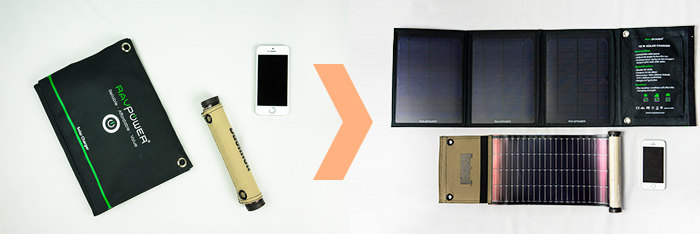
Depending on the type of panel, there are models that can be folded very compactly. When considering this, aim to create a model that is both output and portability.
Grommets and device storage pockets for panel mounting
If you are charging while walking, the solar charger is usually placed on the front of your backpack to allow sunlight to come into contact with your back. In this case, there must be a free grommet at the corners of the panel. There are at least two on the top left and right, but to secure it more firmly, it is also equipped with other parts to improve usability. Just to be sure to check it before purchasing.
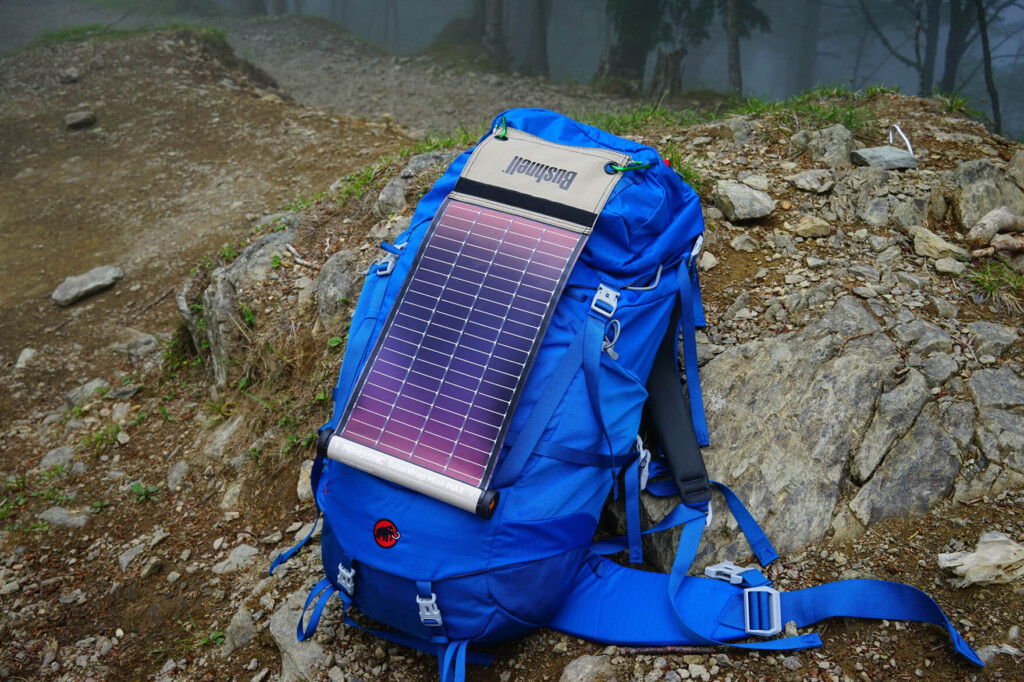
It is convenient to choose a model with at least the open grommets on the left and right so that they can be hung from the backpack.
When connecting and charging equipment while generating electricity, there is a modest but important issue that it is difficult to find where to store the equipment if there is no cable long enough to store the device in your backpack. In such cases, a solar charger comes with a small pouch for storing electronic devices, making it convenient to store your devices safely and easily.
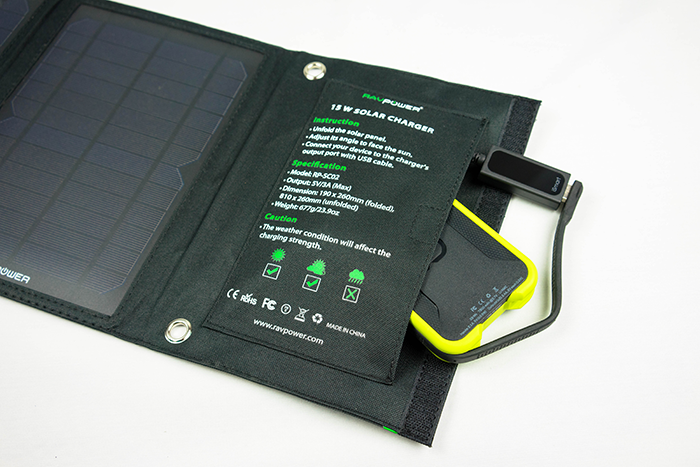
It's rather convenient when you can put a mobile battery in the pouch that comes with the solar charger. However, be careful not to jump out while walking.
Incidentally, lithium-ion batteries, which are used as rechargeable batteries, often have strong heat while charging, and if left in direct sunlight, they can cause too much heat and cause the device to stop functioning (charging may stop). It is best to store your device in a place where the temperature is as low as possible while charging, so when charging, make sure to store it somewhere hidden away from the sun.
Durability of terminals and cables
Despite the extremely delicate terminals that connect the solar panels to the equipment, there are quite a few models that are surprisingly made in a sloppy way. Considering the risk of breakage, it's best to not have the included cable, but most models come with it, so in that case, make sure to check that it is located in a place that is prone to bend or that it is thin and likely to break easily.
summary
These electronic devices and software that increase safety and convenience have been increasing in recent years, whether they like it or not. Even those who say "it's fine for now" will definitely see more opportunities to use it than they used in the past.
Of course, it is true that not all of these are essential tools for walking the mountains. He also does not deny his attitude of not relying on such science and technology. However, it is also a person's style to actively utilize these to find more comfortable mountain climbing and new fun. The shortest way to safety is to choose the right gear based on correct knowledge and information. I hope this will help you. Of course, when using these electronic devices, it is a fundamental premise that they never rely on them, and that they have the technology to safely descend the mountain even if it becomes unusable.
On the other hand, the solar charger market is still in the current situation where many products are immature and poor. There is little credible product information, and even the manufacturer (agent) who inquired for this article will give you the incorrect information (true story). The prices range from surprisingly low to expensive, and the prices are not very reasonable, so it's hard to find a reliable product. Therefore, we will soon share the results of comparing and verifying models from major manufacturers, so please look forward to it.


![Anker PowerCore 13000 (13000mAh 2-port large capacity mobile battery equipped with Panasonic Cell) iPhone / iPad / Xperia / New MacBook / Android and other compatible compact size [Equipped with PowerIQ & VoltageBoost] Black](https://images-fe.ssl-images-amazon.com/images/I/31XHtW4kpyL._SS100_.jpg)

![Anker PowerPort Solar (21W 2-port USB Solar Charger) Compatible with iPhone 6 / 6 Plus / iPad Air 2 / mini 3 / Xperia / Galaxy S6 / S6 Edge / Android and more [Equipped with PowerIQ]](https://images-fe.ssl-images-amazon.com/images/I/51MyqHCL49L._SS100_.jpg)


